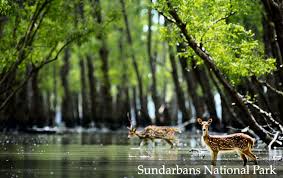Wildlife and ecoturism in West Bengal
West Bengal’s wild life offers a fascinating diversity of terrain, flora and fauna. It
24.9-48.3 48.6-11.4 42.9-11.4 132.3-11.4 132.3s0 89.4 11.4 132.3c6.3 23.7 24.8 41.5 48.3 47.8C117.2 448 288 448 288 448s170.8 0 213.4-11.5c23.5-6.3 42-24.2 48.3-47.8 11.4-42.9 11.4-132.3 11.4-132.3s0-89.4-11.4-132.3zm-317.5 213.5V175.2l142.7 81.2-142.7 81.2z"/>
Subscribe on YouTube
is a delight for nature lovers. It is the home to the World Heritage Site – Sundarbans.
Sundarbans owes its name to the Sundari trees which is found in abundance in this area. The Sunderbans harbors jungle cats, fishing cats, Axis deer, wild boar, Rhesus monkeys, mongooses and the largest estuarine crocodiles in the world. It is the breeding ground for a large number of birds like the Heron, Egret, Cormorant, Fishing Eagle, White Bellied Sea Eagle, Seagull, Tern, Kingfisher as well as migratory birds like Whimprel, Black-tailed Godwit, Little Stint, Eastern Knot, Curlew, Sandpiper, Golden Plover, Pintail, White-eyed Pochard and also Whistling teal. Here, one can discover a wide variety of aquatic and reptile life forms such as the Olive Ridley sea turtle, hard-shelled Batgur Terrapin, Pythons, King cobra, Chequered killback, Monitor and lizards including the Salvatore lizards. In addition to the Bengal tiger, the Sundarbans host many other endangered species like the Ganges River Dolphin, river terrapin, estuarine crocodile etc. The mangrove forest also acts as a natural fish nursery, supporting coastal fishes along the Bay of Bengal. 
The forested area of Northern West Bengal presents overabundance wildlife. Here a land that stretches for 130 kms allows nature to lavish all her boundaries. A lot of wildlife can also be found in the Dooars. Jaldapara Wild Life Sanctuary situated in Alipurduar Sub-Division of Jalpaiguri District in West Bengal is about 124 km from Siliguri. This sanctuary was constituted for the protection of Wild Life, particularly one-horned rhinos, an animal threatened with extinction. The forest is mainly savannah covered with tall elephant grasses. The wild life, in addition to one-horned rhinos, consists of Royal Bengal Tigers, wild elephants, deer, sambhar, barking deer, spotted deer and hog deer, wild pig, bisons and a number of birds, pea fowls. Elephant safaris can be enjoyed at the Sanctuary.
There are five national parks in the state — Sundarbans National Park, Buxa Tiger Reserve, Gorumara National Park, Neora Valley National Park and Singalila National Park. Wildlife includes the Indian rhinoceros, Indian elephants, deer, bison, leopards, gaur, and crocodiles. The state is also rich in bird life. Migratory birds come to the state during the winter. The high altitude forests like Singalila National Park shelter barking deer, red panda, chinkara, takin, serow, pangolin, minivet and Kalij pheasants. Wildlife in these protected areas includes the Indian rhinoceros, Indian elephants, deer, bison, leopards, gaur, and crocodiles. The state is also rich in bird life. The high altitude forests like Singalila National Park shelter barking deer, red panda, chinkara, takin, serow, pangolin, minivet and Kalij pheasants.
Name of Sanctuary, Year of Notification and Total Area
| S.No. |
Name of Wildlife Sanctuary (WLS) |
State |
Established Year |
Area (In km²) |
| 1 |
Ballavpur WLS |
West Bengal |
1977 |
2.02 |
| 2 |
Bethuadahari WLS |
West Bengal |
1980 |
0.67 |
| 3 |
Bibhuti Bhusan WLS |
West Bengal |
1980 |
0.64 |
| 4 |
Buxa WLS
|
West Bengal |
1986 |
267.92 |
| 5 |
Chapramari WLS |
West Bengal |
1976 |
9.6 |
| 6 |
Chintamani Kar Bird
Sanctuary
|
West Bengal |
1982 |
0.07 |
| 7 |
Haliday Island WLS |
West Bengal |
1976 |
5.95 |
| 8 |
Jorepokhri Salamander
WLS
|
West Bengal |
1985 |
0.04 |
| 9 |
Lothian Island WLS |
West Bengal |
1976 |
38 |
| 10 |
Mahananda WLS |
West Bengal |
1976 |
158.04 |
| 11 |
Raiganj WLS |
West Bengal |
1985 |
1.3 |
| 12 |
Ramnabagan WLS |
West Bengal |
1981 |
0.14 |
| 13 |
Sajnakhali WLS |
West Bengal |
1976 |
362.4 |
| 14 |
Senchal WLS |
West Bengal |
1976 |
38.88 |
| 15 |
West Sunderban WLS |
West Bengal |
2013 |
556.45 |
Name of National Parks, Year of Notification and Total Area
| S. No. |
Name of National Park |
Year of Notification |
Total Area(km²) |
| 1 |
Buxa National Park |
1992 |
117.10 |
| 2 |
Gorumara National Park |
1992 |
79.45 |
| 3 |
Neora Valley National Park |
1986 |
159.89 |
| 4 |
Singalila National Park |
1986 |
78.60 |
| 5 |
Sunderban National Park |
1984 |
1330.10 |
| 6 |
Jaldapara National Park |
2014 |
216.51 |
